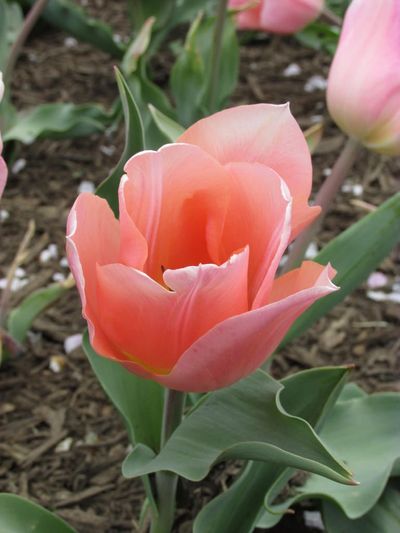What are Triumph Tulips?
Triumph tulips constitute the largest group of tulip varieties with a number of cultivars and colors to choose from for fall bulb planting. The blooms are single and have the classic tulip cup shape. They grow between 10 and 24 inches (25.5 to 60.5 cm.) tall. These tulips bloom in mid- and early spring. They have very sturdy stems, so they stand up well even in bad weather and are excellent plants for cutting gardens. A Triumph bulb is also good for forcing, making this type a good choice for winter growing indoors.
Triumph Tulip Varieties
There are so many varieties of Triumph tulips available with a range of colors, stripes, and flame patterns, so you can really customize your beds and borders:
‘African Queen’ – This one is a real stunner with mauve petals that fade to white- yellow bases, and purple to red on the insides.
‘Atilla’ – For a bold splash of bright color, choose this deep, purple-pink variety.
‘Calgary’ – This variety is a lovely shade of pure white touched by pale yellow flames.
‘Early Glory’ – This pretty, pink tulip is also fragrant and a good choice for cutting or forcing.
‘Golden Prince Claus’ – For the classic, cheerful, and bright yellow tulip, you can’t beat this one.
‘Jan Reus’ – This variety is a stunning shade of deep, dark red.
‘Rembrandt’s Favorite’ – A flower for an artist, this one is burgundy and white with painterly streaks.
There are many, many other cultivars, and it can be hard to choose just a few. Look for bulb mixes to get a variety of colors and patterns.
How to Grow Triumph Tulips
Planting Triumph tulips takes place in the fall for spring blooms. Bury the bulbs to a depth of about five inches (12.5 cm.). Choose a spot that drains well and gets full sun. As your tulips fade, remove the spent blooms, and let the leaves stay in place until they begin to yellow and die. At that time, you can dig up the bulbs and store them somewhere warm and dry until planting again in the fall. Triumph tulip care is pretty easy, but this variety does not do well in warmer climates. Grow them if you are in USDA zones 4 through 7 and avoid in areas that have more extreme warm weather and very hot summers.
